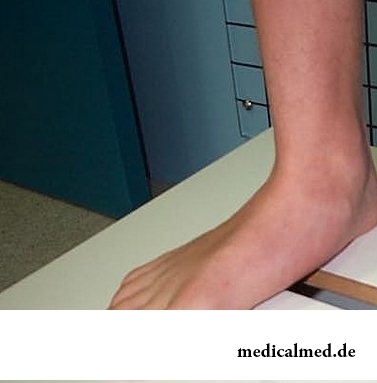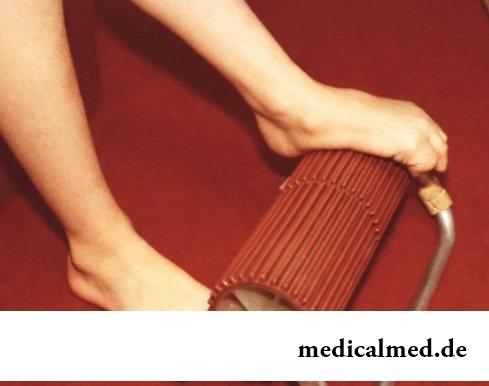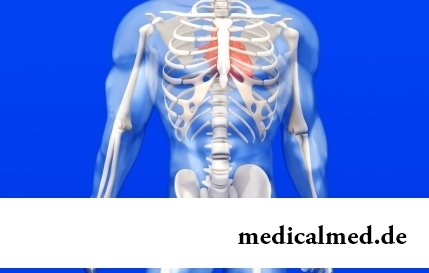





Flat-footedness
Short characteristic of a disease

Flat-footedness is quite paradoxical disease. On the one hand, each person heard about it, but with another – only the few people precisely represent how it proves what degrees of flat-footedness exist and what this disease is dangerous by. We tried to answer these and many other questions in our article.
It is known that in normal, natural state of stop of the person has two arches – longitudinal (on an inner edge) and cross (between fingers around their bases). These arches perform very important function – maintain balance when walking and protect skeleton bones from excessive loadings. In the absence of foot pathologies successfully cope with this task, working together with strong sheaves and muscles. Flat-footedness at children and adults is shown in that case when the muscular and copular device weakens. At the same time foot settles, becomes flat (for this reason the disease received the name), loses an opportunity to perform spring (shock-absorbing) function. Depending on what arch is exposed to pathological changes, allocate:
- metatarsus latus – a rasplastannost of front department of foot;
- longitudinal flat-footedness – flattening of the longitudinal arch;
- the combined form – both arches are exposed to changes.
At flat-footedness when walking and other loadings an organism will protect from jolting a backbone and joints, however, they badly cope with this task as are initially intended for another at all. As the result, flat-footedness which symptoms can arise at any age leads to a bystry conclusion of joints out of operation. The main danger of this disease also consists in it, the patient suffers not only from bystry exhaustion, but also constants, enough severe pains when walking, pathological disturbances of a bearing, arthrosis and other serious violations.
Types of flat-footedness
The typology of flat-footedness is based on the reasons leading to development of a disease. Researchers allocate:
- inborn flat-footedness – occurs at children seldom, is a consequence of the defects which appeared during formation and fetation;
- the acquired flat-footedness – can arise at any age, is subdivided on traumatic, rachitic, static and paralytic;
- traumatic – this form is shown after injuries, fractures of bones of foot, damage of soft tissues;
- rachitic flat-footedness – treatment of this type of a disease is required after the postponed rickets which breaks natural formation of bones of foot;
- static form – its emergence is connected with the excess weight, too strong loads of foot, for example, during sports activities, and also some other factors;
- paralytic flat-footedness – arises after the paralysis of muscles of foot characteristic of poliomyelitis and some other orthopedic diseases.
Flat-footedness – symptoms and a clinical picture
The main symptoms of a disease easily are defined without any special diagnostic procedures. At flat-footedness:
- footwear is worn out also with external, and from the inside;
- quickly there is a feeling of exhaustion when walking;
- there are spasms and puffiness of legs;
- it is necessary to buy footwear on one, and even is two sizes more (it is connected with the fact that foot increases on width).
There is a wish to notice that the above described symptoms are characteristic also of some other diseases therefore at the first unpleasant feelings it is better for you to see a doctor who will examine foot and if necessary will direct you to a radiographic research for statement of the exact diagnosis.
Flat-footedness degrees
Severity of a disease depends on that how strong pathological changes happened to foot and the copular device.
At an early stage of a disease doctors reveal the slight dysfunction of feet which is followed by fatigue by the end of day. The foot form at the same time does not change.
The I degree of flat-footedness – symptoms are expressed stronger, when pressing on foot slight pains develop. By the evening the leg of the person quite often swells up, but again returns the normal form after rest.
The II degree – foot is spread, the arches practically disappear that results in considerable difficulties when walking. Pains cover all leg, are characterized by high intensity and duration.
The III degree – in this case leads flat-footedness at children and adults to accurately expressed deformations of foot, severe pains when walking, to decrease in working capacity and falling of quality of life. The person is not able to move in usual footwear any more.
Let's notice also that flat-footedness degrees quickly enough replace each other because of rapid progressing of a disease. It means that the earlier you see a doctor, the chance to avoid serious complications – pains, a kosolapiya, disproportion of the lower extremities, diseases of feet, joints and the coxofemoral device is higher.
Flat-footedness – treatment and prevention of a disease

Many people consider that to treat flat-footedness – simply. Actually, at late stages of pathology to get rid of deformations of foot very difficult, and at times at all it is impossible. In this case flat-footedness at children and adults can only be braked, but not to cure completely. For this reason early diagnosis of a disease and the timely address to the doctor are so important.
Both longitudinal, and metatarsus latus recover only by means of an integrated approach. For removal of pain physiotherapeutic procedures and medicines are used. The remedial gymnastics which can be done also in house conditions is very effective. She strengthens the copular device, trains muscles, creates a correct posture and a stereotype of walking. Only the doctor as flat-footedness differently proves depending on the speed of development of pathology, age of the patient and some other factors can appoint an effective set of exercises.
For improvement of blood circulation in the field of feet prescribe patients trays for legs and massage procedures. Also special orthopedic insoles which unload painful sites will be extremely useful adjust initial deformations of a disease. The started flat-footedness which symptoms are shown especially brightly is adjusted by means of the orthopedic footwear made by the individual order.
Surgical intervention is urgent when the disease leads to the most severe pains and impossibility independently to move even in special footwear.
Whether it is possible to prevent emergence and development of pathology of the arches of feet? Yes, it is possible! Prevention of flat-footedness consists in the choice of the correct, safe footwear, regular surveys at the specialist orthopedist and restriction of loads of foot.
Except people, only one living being on the planet Earth – dogs suffers from prostatitis. Here really our most loyal friends.

It is known that the person for 80% consists of water which participates in all processes of an organism. The person loses liquid daily – in...
Section: Articles about health
The next flu epidemic leads to the next panic, from year to year we give in on these manipulations: professionally alarming voice of the announcer in news, reports with calculation of the died patients, an interview with people in white dressing gowns and advertizing of anti-influenza means ра...
Section: Articles about health
The person, as well as all other beings living on our planet feels weather changing. It is the normal meteosensitivity which is not causing to healthy people of special troubles. Meteodependence, on the contrary, is the morbid condition which is characterized by an exacerbation of chronic illnesses at change of air temperature, differences of atmospheric pressure, wind strengthening, magnetic storms and other "surprises" on which the nature is so generous. The people suffering from meteodependence have to з...
Section: Articles about health
So, you resolved to lose weight. And now you try to understand what to begin with: from exercise stresses or a diet? And how to make, h...
Section: Slideshow
The dietology, as well as other sciences, does not stand still. Food stuffs are exposed to comprehensive study, and scientists obtain new information on their properties and influence on a human body. Unfortunately, this reasonable and natural process from time to time д...
Section: Articles about health
For many women the word "fat" sounds as a sentence. In aspiration to an ideal figure they try to exclude, first of all, from the menu all dishes containing fats without having at the same time a clear idea of a role of these substances in exchange processes, and of effects for health with which food restrictions of this sort are fraught. For what the human body needs fats and as their deficit in a diet is shown, we also will try to find out....
Section: Articles about health
Nightmares belong to the most unpleasant frustration. Statistically, they happen at 4% of adults, and almost at 70% of children and...
Section: Articles about health
Quite large number of people adheres to the principles of vegetarian food. But how to be if in a family of vegetarians there are children? Whether it is possible to eat also it the same as to parents, or after all the children's organism is not adapted for the use only раст...
Section: Articles about health
Each person has easy indispositions which he transfers "standing", trying not to ask for medical care. Arguments at the same time are adduced same: "it is a trifle, itself will pass", "I have too many important issues", "there are no wish to spend time for doctors", etc. At good shape of health, normal working capacity and lack of suspiciousness dislike for complaints to such problems is quite natural. It is not the most correct, but very widespread type of behavior. I am glad...
Section: Articles about health
The brain of the person is studied not one hundred years, but the quantity of the riddles connected with this body increases rather, than reducing...
Section: Articles about health
Sugar - the digestible refined product which is not of special value for an organism of the modern person. The use of sugar in food is based rather on the psychological dependence caused by desire to indulge itself with something tasty, and in дальнейш...
Section: Articles about health
Diapers for adults – individual one-time means of hygiene which in some situations is irreplaceable and from such situations any person is not insured. Though nobody perceives need of their use with enthusiasm, however without such means already problematic situation could be heavier....
Section: Articles about health
The sudden heat on all body which is followed by perspiration and a cardiopalmus – the phenomenon familiar to many people. Most often t...
Section: Articles about health
What they, women? Beautiful, gentle, passionate and at the same time windy, gusty, and nervous. And what is stranger: have all these qualities of the woman at the same time. But here only the mood their time sharply changes on completely opposite: in the morning...
Section: Articles about health
Within several decades of our compatriots convinced that the use of butter nasty affects a condition of coronary vessels. As a result the reputation of a product was impaired thoroughly a little, and many almost ceased to include it in the diet, having given preference "to safer" to vegetable fats. Meanwhile, the last researches showed that harm of butter for health is strongly exaggerated. But the product has a number of unique properties, to...
Section: Articles about health
The majority of gynecologic diseases prove three main signs, each of which speaks about need to the visa...
Section: Articles about health
The phenomenon of improvement of a condition of the patients at administration of drugs who are not containing active agents, so-called effect of placebo is known long ago. At the end of the 18th century the American doctor Perkins began to treat people the "miracle" sticks made of a spl...
Section: Articles about health
The popular expression "run from a heart attack" became the motto of the people supporting active lifestyle. Moreover, run became a peculiar fashionable tendency: sales of racetracks and the accompanying goods for run are at permanently high level. Whether really it is possible for one and all people and it is necessary to run to receive the portion of health, a charge of cheerfulness and good mood?...
Section: Articles about health
Vitamin complexes belong to the most popular drugs, probably, in our country there is no person who was not hearing about a floor...
Section: Articles about health
Statistically, pathologies of a thyroid gland in the world more than 500 million people have. Failures in work of this body lead to heavy disbolism, development of heart diseases, vessels, a reproductive and nervous system. In hard cases excessive...
Section: Articles about health
The state of health of the person in many respects depends on food. The organism will well function if during food it receive only useful substances, necessary vitamins and microelements. In this case there will be no problems with digestion, with excess weight, and intellectual and physical activity will remain at the high level....
Section: Articles about health
Food with the increased content of sugar is attractive to most of people - it is scientifically confirmed fact. Business here not in a nevozder...
Section: Articles about health
On health of the person physicians know about salutary action of animals long ago. About 7 thousand years ago great Hippocrates recommended to the patients riding walks for strengthening of a nervous system and increase in vitality....
Section: Articles about health
For many spouses the question of planning of a family is one of the main. The problem of the choice of effective and safe contraceptives at the same time comes out on top. Russians still not often resort to operation of a vasectomy extremely popular in the USA, and also in some European and Asian countries. The reason is simple: most of men simply do not possess the complete information about specifics and effects of this procedure. Let's try to meet this lack and to acquaint readers about those...
Section: Articles about health
Cellulitis - very widespread cosmetic shortcoming which arises approximately at 80% of women sooner or later. Emergence ег...
Section: Articles about health
Proofs of efficiency of Mildronate at treatment of coronary heart disease with stenocardia can be found in many publications of the end of the twentieth century. Researches were conducted since 1984, including placebo - controlled effects. In total клиничес...
Section: Articles about health
Coffee – favourite drink of many. For the last decades it more than once already declared very harmful, extremely useful and even necessary for normal life activity. In spite of the fact that this product became for us usual for a long time, there are many myths about properties of coffee and its impact on a human body. Readers can get acquainted with the most widespread of similar delusions today....
Section: Articles about health
